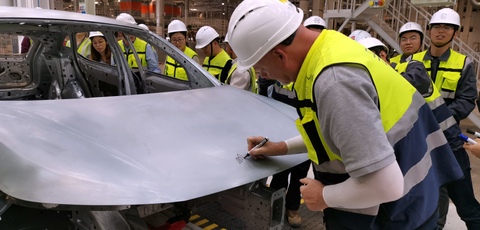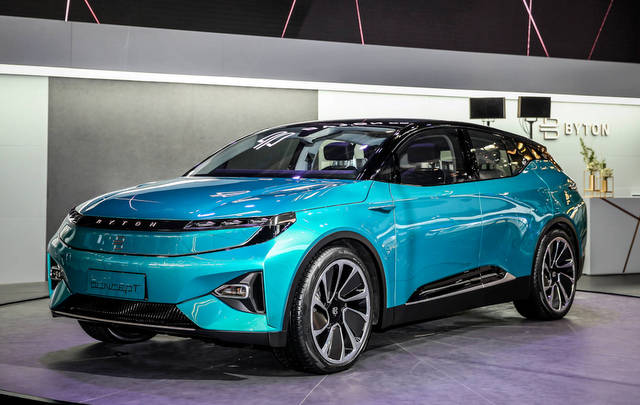Electric SUV Launches in China This Year; U.S. Next
We didn’t get to see or drive the car, but one of our colleagues did –and he loved it. Like many other automotive start-ups, Byton is dribbling out tidbits about its upcoming car, which the company’s go-to-market director describes as a “smart device.”

Jose Angelo Guerrero, the North American go-to-market director quoted above, gave a recent gathering of automotive journalists an update on the Byton story and Clean Fleet Report was able to schedule an exclusive interview with him. Guerrero has the credentials to drop the car reference since he’s a bona fide car guy, working at BMW bringing that company’s electrified products to market—the Mini-E, i3 and i8. He’s quick to point out that while working on BMW’s performance M-Series, he fought to keep manual transmissions as an option.
Byton’s first product on the market is the M-Byte, an all-electric premium crossover that will join the Tesla Model X, Jaguar I-Pace and Audi E-Tron (and the coming Mercedes EQC) in what is becoming a crowded market, given its relatively small size. Of course, Byton isn’t the only new electric crossover that will be on the American market by next year (2020). The Byton M-Byte will launch first in the country with the largest EV market, which also happens to be the main source of Byton’s funding and the location of the M-Byte’s production facility—China.
Big Emphasis on the Interior
Guerrero said the M-Byte has some key goals:
- Premium engineering and design
- A 5-Star Crash Racing from NHTSA
- An affordable price point—the low $50,000s well-equipped
- A one-of-a-kind user interface
He made a point that this is “not just the next generation EV” since that is something several companies are bringing to market. The M-Byte is the “next generation smart device.”

The exterior, from seeing the concept in person and viewing photos of the prototype version cuts a smooth and sporty profile. But inside is where the product differentiation is clear.
Two screens are in front of the driver, neither of which has a precursor in a production car. The smaller one is a seven-inch tablet embedded in the center of the steering wheel. Cleverly, it doesn’t move when the wheel turns and affords full access to all of the electronic goodies on board.

The second screen is the signature of the M-Byte. It underpins Guerrero’s “smart device” claim. At 48 inches wide and nine inches tall, it could easily take the place of someone’s home entertainment unit, especially given its capabilities. It has three sections and Guerrero assured us that the driver-oriented section would only contain driver-oriented information.
A third screen/tablet is embedded in the armrest, offering another method of access to the car’s technologies.

Byton calls it the “Shared Experience Display.’ It definitely looks forward to fully autonomous driving, which of course is part of the Byton plan. Guerrero said the hardware and software are 5G upgradeable and should be capable of holding its own in the market for the next decade.
As autonomous technology and connectivity advances such as facial recognition and driver-eye monitoring come on board, the M-Byte and future Byton “smart devices” become part of an “integrated digital life.”
The Sales Model
Building the M-Byte and integrating all of its technology is one challenge; establishing a sales channel to get them in customer hands and then support them after the sale is a bigger one.

The Byton solution in the U.S., according to Guerrero, will be a hybrid direct sales model. There will be Byton-owned stories—the just-opened Shanghai flagship store is the prototype—augmented by partner galleries. Byton envisions those stores and galleries as another part of the process of “co-creating” the car. Retail partners in the U.S. will be announced soon.
The audience for this technology-heavy “smart device” is the millennial generation. Beyond that core group, Guerrero said he expects like Apple found, the technology will draw in a wide range of interest. Initial customers should be similar demographically to BMW X3 and X5 buyers, though the company hopes to help create a new category/niche between BMW and Jaguar. The service plan is yet to be announced, but Guerrero said they’ve committed to a “Lexus-style” experience and will also explore Tesla’s mobile service model.

Currently Byton is actively marketing the M-Byte in China through the WeChat app. In the U.S. they’re gathering deposit-less “reservations” from interested parties. At least the Chinese version of the production models should be appearing soon with the U.S. models not far behind.
Make sure to opt-in to the Clean Fleet Report newsletter (top right of page) to be notified of all new stories
and vehicle reviews.
This is one of a series of stories from Western Automotive Journalists’ recent Media Day program held in Carmel Valley, California.
Another WAJ Media Day Story: Flash Drive: Alfa Romeo Stelvio
More Byton News:
CES News: Byton Shows Off Interior
News: Byton Introduces Electric SUV
Video: First Test Drive of M-Byte by Alex Guberman of E for Electric
More EV SUV Competition
Road Test: 2019 Jaguar I-Pace
Flash Drive: Tesla Model X
News: Audi Debuts the E-Tron Electric SUV
NewsL BMW iX3 Coming to U.S. in 2020
News: 2020 Mercedes-Benz EQC 400 Makes Its Debut

3 thoughts on “Interview: Byton Edges Closer To Market”